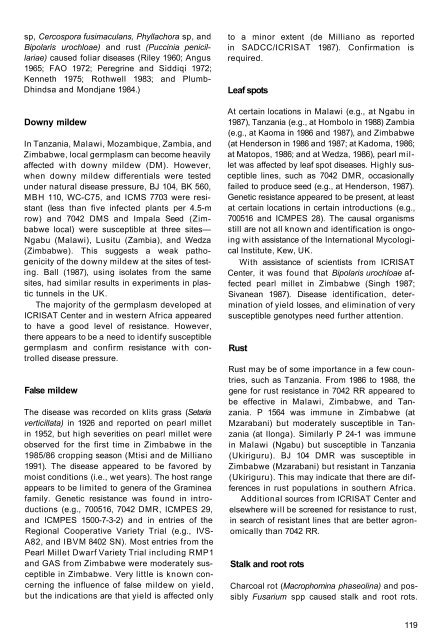Sorghum Diseases in India
Sorghum Diseases in India
Sorghum Diseases in India
You also want an ePaper? Increase the reach of your titles
YUMPU automatically turns print PDFs into web optimized ePapers that Google loves.
sp, Cercospora fusimaculans, Phyllachora sp, and<br />
Bipolaris urochloae) and rust (Pucc<strong>in</strong>ia penicillariae)<br />
caused foliar diseases (Riley 1960; Angus<br />
1965; FAO 1972; Peregr<strong>in</strong>e and Siddiqi 1972;<br />
Kenneth 1975; Rothwell 1983; and Plumb-<br />
Dh<strong>in</strong>dsa and Mondjane 1984.)<br />
Downy mildew<br />
In Tanzania, Malawi, Mozambique, Zambia, and<br />
Zimbabwe, local germplasm can become heavily<br />
affected with downy mildew (DM). However,<br />
when downy mildew differentials were tested<br />
under natural disease pressure, BJ 104, BK 560,<br />
MBH 110, WC-C75, and ICMS 7703 were resistant<br />
(less than five <strong>in</strong>fected plants per 4.5-m<br />
row) and 7042 DMS and Impala Seed (Zimbabwe<br />
local) were susceptible at three sites—<br />
Ngabu (Malawi), Lusitu (Zambia), and Wedza<br />
(Zimbabwe). This suggests a weak pathogenicity<br />
of the downy mildew at the sites of test<strong>in</strong>g.<br />
Ball (1987), us<strong>in</strong>g isolates from the same<br />
sites, had similar results <strong>in</strong> experiments <strong>in</strong> plastic<br />
tunnels <strong>in</strong> the UK.<br />
The majority of the germplasm developed at<br />
ICRISAT Center and <strong>in</strong> western Africa appeared<br />
to have a good level of resistance. However,<br />
there appears to be a need to identify susceptible<br />
germplasm and confirm resistance with controlled<br />
disease pressure.<br />
False mildew<br />
The disease was recorded on klits grass (Setaria<br />
verticillata) <strong>in</strong> 1926 and reported on pearl millet<br />
<strong>in</strong> 1952, but high severities on pearl millet were<br />
observed for the first time <strong>in</strong> Zimbabwe <strong>in</strong> the<br />
1985/86 cropp<strong>in</strong>g season (Mtisi and de Milliano<br />
1991). The disease appeared to be favored by<br />
moist conditions (i.e., wet years). The host range<br />
appears to be limited to genera of the Gram<strong>in</strong>ea<br />
family. Genetic resistance was found <strong>in</strong> <strong>in</strong>troductions<br />
(e.g., 700516, 7042 DMR, ICMPES 29,<br />
and ICMPES 1500-7-3-2) and <strong>in</strong> entries of the<br />
Regional Cooperative Variety Trial (e.g., IVS-<br />
A82, and IBVM 8402 SN). Most entries from the<br />
Pearl Millet Dwarf Variety Trial <strong>in</strong>clud<strong>in</strong>g RMP1<br />
and GAS from Zimbabwe were moderately susceptible<br />
<strong>in</strong> Zimbabwe. Very little is known concern<strong>in</strong>g<br />
the <strong>in</strong>fluence of false mildew on yield,<br />
but the <strong>in</strong>dications are that yield is affected only<br />
to a m<strong>in</strong>or extent (de Milliano as reported<br />
<strong>in</strong> SADCC/ICRISAT 1987). Confirmation is<br />
required.<br />
Leaf spots<br />
At certa<strong>in</strong> locations <strong>in</strong> Malawi (e.g., at Ngabu <strong>in</strong><br />
1987), Tanzania (e.g., at Hombolo <strong>in</strong> 1988) Zambia<br />
(e.g., at Kaoma <strong>in</strong> 1986 and 1987), and Zimbabwe<br />
(at Henderson <strong>in</strong> 1986 and 1987; at Kadoma, 1986;<br />
at Matopos, 1986; and at Wedza, 1986), pearl millet<br />
was affected by leaf spot diseases. Highly susceptible<br />
l<strong>in</strong>es, such as 7042 DMR, occasionally<br />
failed to produce seed (e.g., at Henderson, 1987).<br />
Genetic resistance appeared to be present, at least<br />
at certa<strong>in</strong> locations <strong>in</strong> certa<strong>in</strong> <strong>in</strong>troductions (e.g.,<br />
700516 and ICMPES 28). The causal organisms<br />
still are not all known and identification is ongo<strong>in</strong>g<br />
with assistance of the International Mycological<br />
Institute, Kew, UK.<br />
With assistance of scientists from ICRISAT<br />
Center, it was found that Bipolaris urochloae affected<br />
pearl millet <strong>in</strong> Zimbabwe (S<strong>in</strong>gh 1987;<br />
Sivanean 1987). Disease identification, determ<strong>in</strong>ation<br />
of yield losses, and elim<strong>in</strong>ation of very<br />
susceptible genotypes need further attention.<br />
Rust<br />
Rust may be of some importance <strong>in</strong> a few countries,<br />
such as Tanzania. From 1986 to 1988, the<br />
gene for rust resistance <strong>in</strong> 7042 RR appeared to<br />
be effective <strong>in</strong> Malawi, Zimbabwe, and Tanzania.<br />
P 1564 was immune <strong>in</strong> Zimbabwe (at<br />
Mzarabani) but moderately susceptible <strong>in</strong> Tanzania<br />
(at Ilonga). Similarly P 24-1 was immune<br />
<strong>in</strong> Malawi (Ngabu) but susceptible <strong>in</strong> Tanzania<br />
(Ukiriguru). BJ 104 DMR was susceptible <strong>in</strong><br />
Zimbabwe (Mzarabani) but resistant <strong>in</strong> Tanzania<br />
(Ukiriguru). This may <strong>in</strong>dicate that there are differences<br />
<strong>in</strong> rust populations <strong>in</strong> southern Africa.<br />
Additional sources from ICRISAT Center and<br />
elsewhere will be screened for resistance to rust,<br />
<strong>in</strong> search of resistant l<strong>in</strong>es that are better agronomically<br />
than 7042 RR.<br />
Stalk and root rots<br />
Charcoal rot (Macrophom<strong>in</strong>a phaseol<strong>in</strong>a) and possibly<br />
Fusarium spp caused stalk and root rots.<br />
119








